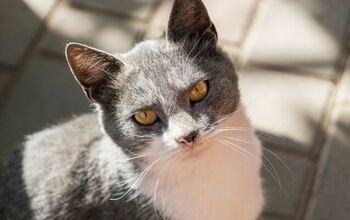How Hot is Too Hot for Your Cat?

Summer is officially here, bringing longer days, beautiful sunshine, and that relaxed summer holiday atmosphere that we all look forward to. But while you’re busy enjoying the warmth, your cat may be dealing with a different experience. Unlike humans, cats aren’t efficient at regulating their body temperature, making them highly susceptible to overheating, even in temperatures that you may consider comfortable.
As cat parents, it’s absolutely crucial that we understand the risks of heat exhaustion and heat stroke, learn to recognize the subtle warning signs, and be prepared to react appropriately. In this guide, I’ll explain exactly how hot is too hot for cats, provide you with the information necessary to keep your cat safe, and share some practical tips for keeping them cool on even the hottest summer days. After all, we want them to enjoy their summer vacation, too!
Understanding How Heat Affects Your Cat
The first step in keeping your cat safe is understanding how their body responds to and interacts with heat, especially extreme heat, and why they are so vulnerable to overheating. When the temperatures climb, humans sweat to cool down. Our cats, however, have a harder time regulating their body temperature and staying comfortable.
What is Considered Normal Cat Body Temperature?
A healthy cat’s normal body temperature ranges between 100.4∘F and 102.5∘F (38∘C and 39.2∘C). This may seem a bit higher than expected because it’s higher than what is considered normal, but their bodies do generally run warmer. If your cat’s temperature rises beyond this range, their body has to work harder to cool it back down. If they are unable to get back to a healthy temperature quickly enough, they could face severe health conditions, such as heat exhaustion and ultimately, heat stroke.
How Cats Regulate Temperature (And Why It’s Limited)
While cats don’t sweat like people, there are a few natural ways they may try to cool themselves off. However, it’s essential that we recognize these methods of cooling and regulating body temperature are significantly less efficient, leaving them vulnerable to overheating.
- Panting: Dogs are known to pant heavily when they need to cool down. With cats, panting isn’t as common and usually means a more serious situation – they are highly stressed, in pain, or significantly overheating. If you see your cat panting, it’s a red flag.
- Sweating: Previously, I said that cats don’t sweat like humans, but they do have a few (very few) sweat glands. These are primarily found on their paw pads. You may occasionally see damp paw prints on a cool surface if your cat is hot, and they can help a tiny bit, but they aren’t effective as a major cooling strategy for the entire body.
- Grooming/Saliva Evaporation: Cats often groom themselves when they’re feeling overheated. As the saliva evaporates from their fur, it offers an evaporative cooling effect, similar to how sweat evaporating off our skin cools us.
- Seeking Shade/Cool Surfaces: The most common way a cat will try to cool down is by seeking out a shaded, cool environment. For example, they may try stretching out on a cool tile or hardwood floor. While this helps, it’s often not enough in truly hot temperatures.
So, How Hot is Too Hot for Cats?
There isn’t a single “magic number” that makes an environment too hot for every cat. Instead, there are many different individual factors that will play a role. However, a general rule of thumb is that temperatures of 80°F (26.7°C) and higher are considered risky for most cats. This is especially true if combined with these risk factors:
- High Humidity: This makes it harder for evaporative cooling methods (such as panting and saliva evaporation) to work effectively, trapping heat in the body. A 70°F day with high humidity can be more dangerous than an 80°F day with low humidity.
- Enclosed Spaces: When discussing this topic, we typically refer to the life-threatening risk of leaving a cat in a parked car. Even for “just a minute” with the windows cracked, the temperatures inside can rise quickly turning the vehicle into an oven. But this also applies to unventilated rooms, sunrooms, or carriers left in direct sunlight.
- Individual Sensitivity: Just like people, some cats are going to be more susceptible to heat than others. This is why it’s so important for cat parent to get to know their cats, their usual behaviors, and their comfort levels.
Is Your Cat at High Risk for Heat Exhaustion?
While any cat can suffer from heat exhaustion or heat stroke, there are some that are at a significantly higher risk of overheating. Consider whether your cat fits into any of the following high-risk groups:
- Age: Very young kittens and senior cats are less efficient at regulating their body temperatures, making them more susceptible to extreme temperatures.
- Brachycephalic (Flat-Faced) Breeds: Cat breeds with flatter faces, like Persians, Himalayans, and Exotic Shorthairs, are particularly susceptible to overheating. Their facial structure means they have shortened airways, making it more difficult for them to breathe efficiently, which in turn makes it harder for them to cool themselves through panting.
- Coat Types: A dense coat can offer some insulation against heat. However, long-haired or dense-coated cats can struggle more in high temperatures, especially if their undercoat isn’t regularly groomed out.
- Activity Level: Overly active or playful cats are at risk of pushing themselves too hard in a hot environment, which can cause their internal temperature to rise.
- Health Conditions: Cats with underlying health issues, such as heart disease, respiratory problems (like asthma), obesity, or arthritis (which limits their ability to move to cooler spots), are at an increased risk.
If your cat falls into any one (or multiple) of these high-risk categories, knowledge is power. Recognizing that they are more vulnerable to overheating is the first step in taking the steps necessary to keep them safe and healthy.
Tips and Tricks to Keep Your Cat Cool and Comfortable
Once you understand how heat affects your cats, the next step is to identify ways you can prevent them from getting too overheated, especially during the warmer summer months. Prevention is always the best approach to avoiding the dangers of heat exhaustion and heat stroke. Here are a few proactive measures that can help keep your cat safe:
Strategies for Keeping Cool Indoors
For most cats, the hottest days of the year are going to be spent indoors. Therefore, it’s our job to ensure that their home environment is a cool haven.
- Air Conditioning: Obviously, the easiest way to keep the indoor temperature comfortable is by using air conditioning (if it’s available). Set it to a comfortable, consistent temperature. The ideal temperature will be between 75°F and 80°F (24°C and 26.7°C).
- Fans: While fans won’t cool the air, they do create air circulation, which can help your cat feel more comfortable by encouraging evaporative cooling. Position fans to circulate air specifically through the rooms where they spend most of their time. But avoid pointing the fans directly at your cat.
- Open Windows: Speaking of air circulation, if you don’t have air conditioning, try opening windows on opposite sides of the house to create natural cross-ventilation. You can pair this with your fans to make it even more effective. But make sure you have secure screens to keep your cat safe!
- Curtains/Blinds: Keep the curtains and blinds in your home closed during the hottest parts of the day, especially on any windows that receive direct sunlight.
- Cool Spots: Make sure your cat always has access to naturally cooler areas of your home. This could include a basement room, tile floors, or rooms with less sun exposure.
Prioritize Hydration
Cats are prone to dehydration on a regular day. So, you can imagine how much greater this risk is when the temperatures are rising. Luckily, there are steps you can take to encourage your cat to boost their hydration levels and set them up for success.
- Provide Plenty of Fresh Water: Always make sure your cat has access to multiple bowls of fresh, clean water in various locations throughout your home. This will encourage your cat to drink more simply because it’s more convenient.
- Water Fountains: Cats are naturally drawn to moving water, making a pet water fountain an excellent way to encourage your cat to drink more. We use the Catit Flower Fountain with Triple Action Filter for our three cats.
- Wet Food: Incorporating wet food into your cat’s diet, either in place of kibble or in combination with their kibble, is a great way to boost their hydration, as wet food has a much higher level of water content.
- Ice Cubes: Some cats enjoy playing with or licking ice cubes. Adding a few to their water bowl may tempt them to drink a little more, help cool them off, and also offer some fun mental enrichment as they work to catch their “frozen prey.”
Cooling Aids and DIY Cooling Accessories
There are several products on the market designed to help cool your cat when temperatures climb. But if you’re on a budget, don’t worry! There are also easy and budget-friendly solutions to create practical cooling accessories of your own.
- Cooling Mats: These are pressure-activated, gel-filled mats designed to absorb and dissipate heat, creating a comfortable, cool surface for your cat to lie on.
- Cooling Bandanas: Using the same evaporative cooling concept that your cat does naturally, you can cool your cat off even if they’re on the move around your home. Wet the cooling bandana and place it around their neck. As the water evaporates, your cat can benefit from the cooling sensation.
- Damp Towels: Lay a slightly damp (not soaking wet) towel on the floor in a shaded area of your home. Once again, the evaporative cooling will create a cool, comfortable space.
- Frozen Water Bottles: This is a simple DIY. Fill a plastic bottle with water and place it in the freezer. Wrap the frozen bottle in a thin towel and place it near your cat’s favorite resting spot to help them cool off.
Recognizing the Warning Signs of Heat Exhaustion and Heat Stroke
Even with the best preventative measures, every cat parent should be familiar with the warning signs of heat-related illnesses in cats. Cats are masters of hiding discomfort, so you must watch for even the most subtle signs of trouble.
Heat exhaustion is the initial stage of overheating. While serious, it’s generally less life-threatening than heat stroke if it’s recognized and addressed quickly. Symptoms often include:
- Excessive panting
- Drooling
- Reddened gums/tongue
- Vomiting/diarrhea
- Increased heart rate
- Restlessness/agitation
- Lethargy/weakness
If heat exhaustion is left unaddressed, it can quickly progress to a more severe and life-threatening condition known as heat stroke. This requires immediate veterinary help as it can quickly lead to organ damage. Signs of heat stroke include:
- Vomiting
- Bloody diarrhea
- Bluish or pale gums
- High body temperature
- Stumbling/disorientation
- Seizures/tremors
- Collapse/loss of consciousness
You know your cat best. If you notice any change to their normal behavior or any of the above warning signs, trust your instincts. It’s always better to err on the side of caution.
When dealing with heat exhaustion or heat stroke, every second counts. Your immediate goal is to safely lower your cat’s body temperature while preparing to transport them to the nearest veterinarian or emergency clinic.
Move them to a cooler space, such as an air-conditioned room or shaded area outdoors. Apply cool (not cold) water to your cat’s paws, ears, groin, and armpits, as these parts of the body have blood vessels close to the surface. Avoid very cold water or ice baths. Do not submerge your cat in cold water. If your cat is conscious and willing to drink, offer small drinks of fresh, cool water. Do not force them to drink.
Before setting out, call your veterinarian to let them know you are coming. This will allow them to prepare for your arrival and provide the fastest possible treatment, giving your cat a better chance of a full recovery.
Ensure You and Your Cat Enjoy This Summer Safely
Cats are vulnerable to overheating, but there are many steps you can take to keep your best friend safe when the temperatures climb. From creating a cool, comfortable environment to encouraging better hydration, the best approach is to prevent a heat-related emergency before it happens. Share this information with other cat parents to ensure everyone enjoys a great summer season!
Join the PetGuide community. Get the latest pet news and product recommendations by subscribing to our newsletter here.

Britt Kascjak is a proud pet mom, sharing her heart (and her home) with her “pack” which includes her husband John, their 2 dogs – Lucifer and Willow – and their 3 cats – Pippen, Jinx, and Theia. She has been active in the animal rescue community for over 15 years, volunteering, fostering and advocating for organizations across Canada and the US. In her free time, she enjoys traveling around the country camping, hiking, and canoeing with her pets.
More by Britt








![Dog Too Hot To Bother With Fur-Plucking Bird [Video]](https://cdn-fastly.petguide.com/media/2022/02/28/8267770/dog-too-hot-to-bother-with-fur-plucking-bird-video.jpg?size=350x220)















